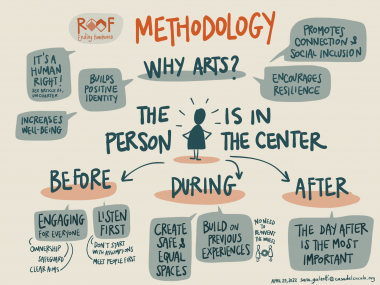The ROOF Call for Artists project - how did we do it?
Edited on
23 August 2022The fields of arts/creativity and homelessness don’t immediately seem to fit together – one is about celebration, joy, expression; the other about poverty, trauma, isolation. And yet, these worlds are colliding together more and more in powerful and unexpected ways.

In 2022, URBACT turned to the arts to bring new opportunities and perspectives to its ROOF project across its 9 partners around Europe. Early in the year, some people of the ROOFnetwork convened a meeting with Arts & Homelessness International and Itinerari Parralleli, two organisations far apart in geography but close to each other in terms of values: AHI is a global network of arts projects working in homelessness based in the UK; IP is a social enterprise working in arts with a social and ethical purpose based in Italy.
The project was ambitious and bold – each of the 9 cities would receive an extra budget to use arts to promote the importance of Housing First and give opportunities to homeless people to take part in meaningful and life-affirming arts project. The understanding of the use of arts was mixed from some cities being aware of creativity’s role to build confidence and supportive networks and to show what is strong about people not wrong about them. And some other cities were entirely new to the arts in this context. Added into the mix was a tight turnaround which gave the project a fascinating, exciting and challenging edge.



When AHI and IP first spoke, we talked about the importance of co-creation and legacy. Co-creation – working on a more equal footing with people with lived experience is gaining momentum as the sector recognises that people nearest the pain are often nearest the solution. Considerations around legacy and what happens in the days and weeks after a project is also important since arts can often generate such joy and hope for people involved.
We needed a light-touch methodology so we developed some training for the cities in co-creation and running arts projects in this sector and spoke to each city individually to find out what they were planning. The results could not have been more diverse – from Ghent wanting to work with a local project called Graffiti to record a song with homeless people in a mobile recording studio to Poznan who wanted to create an art exhibition. You can see all the ideas here.
Not all projects have been completed yet and some have not been able to follow through with their ideas. Arts will always be a small part of the world’s push to end homelessness – housing comes first but that is not the whole story. This project and many others have shown that in order for people to truly move away from homelessness you need to build well-being, resilience, agency and skills as well as new homes.
 Submitted by Hannelore Bonami on
Submitted by Hannelore Bonami on
